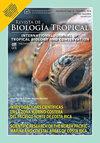Settlement and post-settlement survival of Orbicella annularis and Orbicella faveolata (Scleractinia: Merulinidae) on substrates with coatings
IF 0.6
4区 生物学
Q4 BIOLOGY
引用次数: 0
Abstract
Introduction: One of the main bottlenecks in restoration projects based on sexual reproduction is post-settlement survival, mainly due to competition for substrate with fleshy algae and predation. Therefore, substrates of different shapes and materials have been created and tested, seeking to optimize these processes with attractive surfaces for the larvae and structures where the recruits are protected from predation, and competition is reduced. Objective: To improve settlement and post-settlement survival of two important Caribbean reef-building corals, using different coatings on substrates. Methods: To determine whether substrate coatings properties are favourable to larval settlement in Orbicella annularis, and O. faveolata, collected in Puerto Morelos, Mexican Caribbean, we evaluated their settlement for three weeks on six coatings with a combination of properties. Each coating was designed to provide a combination of two out of three properties: 1) water repellence (hydrophobicity), 2) phosphorescence-based colour, and 3) mineral-enriched surface chemistry. In a separate experiment larvae settlement was tested using coatings with a single property. Finally, we determined the post-settlement survival of O. annularis and O. faveolata on the different coatings for seven weeks. Results: The combination of high hydrophobicity and light blue phosphorescent microparticles and high hydrophobicity and red-orange phosphorescent microparticles resulted in a higher settlement of O. annularis and O. faveolata when compared with other coatings (30.8 - 66.7 % higher). No significant differences were found in the number of larval settled when the water-repellence and the phosphorescence-based were evaluated independently. Post-settlement survival time on substrates was low, with a maximum of 34 days after settlement for O. annularis and 42 days for O. faveolata. Conclusions: In terms of the larval settlement, the combination of the coatings properties appears to play an essential role in the choice of microhabitat for both O. annularis and O. faveolata. But individually these properties did not generate an advantage in the larval settlement. Moreover, some chemical components associated with the coatings may be counterproductive to the survival of the polyps over time.环轮小蠊和黄花小蠊在有涂层的基质上的沉降和沉降后存活
基于有性繁殖的恢复项目的主要瓶颈之一是定居后的生存,主要是由于与肉质藻类和捕食者争夺基质。因此,不同形状和材料的基质已经被创造和测试,寻求优化这些过程,为幼虫提供有吸引力的表面和结构,以保护新兵免受捕食,并减少竞争。目的:研究两种重要的加勒比造礁珊瑚在基底上使用不同的涂层,以提高其沉降和沉降后的存活率。方法:为了确定在墨西哥加勒比海莫雷洛斯港采集的基材涂层是否有利于环轮小轮虫和O. faveolata幼虫的沉降,我们对它们在六种具有综合性能的涂层上的沉降进行了三周的评估。每一种涂层都具有以下三种特性中的两种:1)防水性(疏水性),2)基于磷光的颜色,以及3)富含矿物质的表面化学。在一个单独的实验中,用单一性能的涂层测试了幼虫的沉降。最后,我们测定了环轮虫和蚕豆虫在不同涂层上沉降后7周的存活率。结果:高疏水性浅蓝色磷光微粒子和高疏水性红橙色磷光微粒子的组合可使黄叶菊和黄叶菊的沉降比其他涂层高30.8% ~ 66.7%。在单独评价疏水性和磷光性时,两种防水性的幼虫定居数量无显著差异。沉降后在基质上的存活时间较短,环纹夜蛾沉降后最长可达34天,黄花夜蛾沉降后最长可达42天。结论:就幼虫的沉降而言,包膜特性的组合对环轮夜蛾和黄花夜蛾的微生境选择起着重要的作用。但单独来看,这些特性并没有在幼虫定居中产生优势。此外,随着时间的推移,与涂层相关的一些化学成分可能对息肉的存活起反作用。
本文章由计算机程序翻译,如有差异,请以英文原文为准。
求助全文
约1分钟内获得全文
求助全文
来源期刊

Revista De Biologia Tropical
生物-生物学
CiteScore
1.80
自引率
0.00%
发文量
23
审稿时长
4-8 weeks
期刊介绍:
The Revista de Biología Tropical / International Journal of Tropical Biology and Conservation is a mainstream scientific journal published since 1953 and covered by Web of Science; Science Citation Index; Current Contents; Google Scholar; Scopus, SciELO and nearly 50 additional indices.
A double blind system guarantees you a fair evaluation, and our world class editorial and scientific boards provides a first decision in three working days. The journal is Full Open Access and is widely read where your article can have the highest real impact.
Since its beginning in 1953, the Revista follows these principles: objective and independent evaluation of all manuscripts; transparency in all processes; ethical use of procedures, data, specimens and subjects; fair treatment of all parties; and absolute predominance of scientific rigor over any other aspect.
 求助内容:
求助内容: 应助结果提醒方式:
应助结果提醒方式:


